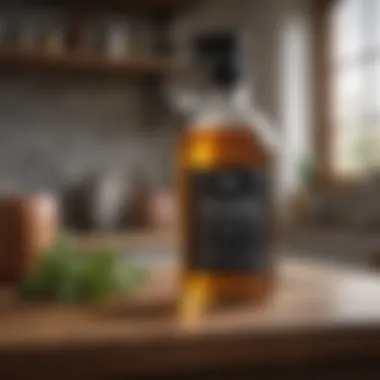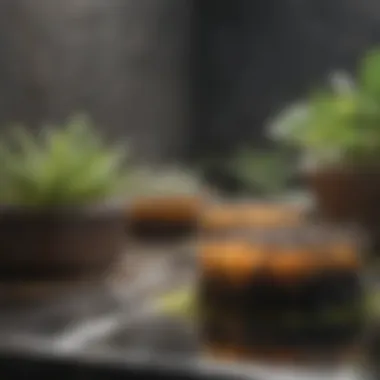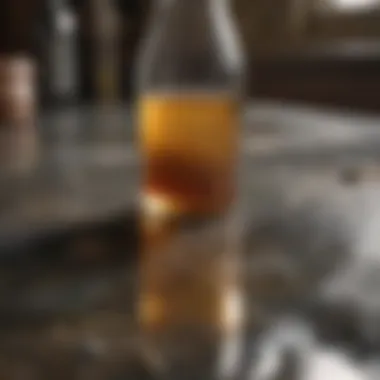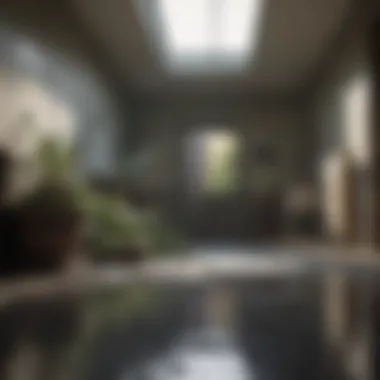Effective Mold Removal with Vinegar: A Natural Approach


Intro
Mold is a widespread issue that many homeowners encounter. It grows in damp and humid areas, often becoming a health hazard and damaging property. Vinegar type, a staple in most kitchens, emerges as a popular natural solution for tackling mold. It not only offers a safe alternative to harsh chemicals but also effectively eliminates various types of mold present in homes. This article aims to present practical advice and insights regarding the use of vinegar in mold removal. With several effective methods at hand, you can create a mold-free environment with ease. Let's explore how vinegar can be a simple yet potent asset in your home maintenance toolkit.
Understanding Mold Growth
Understanding mold growth is crucial for effectively managing and preventing mold problems in living spaces. Mold is not only an eyesore but can result in serious health concerns and structural damage if left unchecked. By comprehending how mold thrives, homeowners and professionals can identify potential risks and take preventive measures. This knowledge fosters a proactive approach to maintaining a clean and healthy environment.
What is Mold?
Mold is a type of fungus that plays a significant role in the decomposition of organic materials. It reproduces through tiny spores that are often invisible to the naked eye. Mold spores are everywhere in the environment; they can enter homes through windows, doors, or on clothing.
Mold can appear in various colors, including black, green, white, or even orange. Each type of mold has different characteristics and needs, but all require moisture to grow. The presence of mold is generally a sign of excessive dampness in a location.
Conditions Favoring Mold Growth
Identifying the conditions that favor mold growth is critical for effective removal and prevention.
Humidity Levels
Humidity levels significantly influence mold growth. Mold thrives in environments where the relative humidity exceeds 60 percent. High humidity creates a suitable atmosphere for mold spores to germinate and proliferate.
Maintaining lower humidity levels is beneficial. The unique characteristic of indoor humidity is that it can be easily controlled with dehumidifiers or proper ventilation. However, in areas where excessive moisture is hard to control, such as basements, it can be a major challenge.
Temperature Ranges
Temperature ranges also play a pivotal role in mold development. Mold generally prefers temperatures between 77°F and 86°F (25°C to 30°C). This range allows for optimal growth.
One should be aware that while certain molds can thrive in colder environments, most common mold types flourish in warmer conditions. Reducing temperatures in vulnerable areas can lessen the chances of mold setting in.
Material Types
The materials within a home can influence the susceptibility to mold. Organic materials such as wood, paper, and fabrics serve as a food source for mold spores.
Non-organic materials, like glass, plastic, and metal, are less prone to mold infestation. However, the presence of moisture can create conditions for mold to attach even to these materials. Homeowners should prioritize choosing mold-resistant materials, especially in areas prone to dampness, to mitigate the risks associated with mold growth.
Health Risks Associated with Mold
Mold is not just a nuisance; it can cause various health problems. People exposed to mold may experience allergic reactions, respiratory issues, and even serious health complications. Vulnerable groups, such as children and individuals with pre-existing conditions, are more susceptible to the effects of mold exposure. Knowing the risks reinforces the importance of early detection and elimination of mold in living spaces.
Vinegar as a Mold Remover
Mold removal is crucial for maintaining a healthy living environment. When it appears, it can affect both the structural integrity of a space and the health of its occupants. Vinegar has gained recognition as an effective solution for combating mold. This section will detail the various reasons vinegar is chosen for mold remediation, its specific types, and how each contributes to the goal of achieving a mold-free home.
Why Choose Vinegar?
Vinegar is selected for mold removal due to its favorable characteristics, which provide several advantages over traditional chemical cleaners.
Non-Toxic Characteristics


Vinegar is primarily composed of acetic acid, making it a non-toxic option for cleaning and mold removal. This is a significant aspect because it minimizes health risks to individuals, especially those sensitive to harsh chemicals found in commercial cleaners. Families with children or pets often lean towards vinegar to ensure safety in their homes. Additionally, it does not emit harmful fumes, a common issue with stronger cleaning agents. These characteristics make vinegar a popular choice for environmentally conscious homeowners. However, its non-toxic nature does mean that it may take slightly longer to effectively remove mold compared to stronger chemical alternatives.
Antimicrobial Properties
Vinegar exhibits notable antimicrobial properties, which contribute to its effectiveness against mold. The acetic acid in vinegar can kill many types of mold spores on contact. This is a key characteristic because it directly addresses the core issue of mold growth. Numerous studies have shown that vinegar is effective against common household molds. Nonetheless, it is important to understand that while vinegar can eliminate surface mold, it may not penetrate deep into porous materials where mold often hides. Thus, it serves as a surface treatment rather than a comprehensive mold eradicator.
Environmental Considerations
In the context of growing environmental awareness, vinegar stands out as an eco-friendly choice for mold removal. It is biodegradable and safe for the environment. Choosing vinegar reduces reliance on harsh chemicals that can contribute to pollution and other ecological issues. This characteristic appeals to individuals looking to maintain a balance between effective cleaning and environmental responsibility. Its wide availability adds to its appeal as a sustainable solution. However, users should be aware that while vinegar is safer for the environment, it has limitations in terms of effectiveness against more resilient mold types.
Types of Vinegar for Mold Removal
Different types of vinegar can be used for mold removal, each with its own characteristics and efficacy. Understanding these variations helps homeowners make an informed choice.
White Distilled Vinegar
White distilled vinegar is often the go-to choice for mold removal. Its high acidity makes it particularly effective against various types of mold and mildew. The key characteristic of this vinegar is its potency, which benefits those dealing with extensive mold infestations. Many users appreciate its effectiveness and low cost. However, its strong smell can be off-putting to some, although it does dissipate quickly. Overall, its efficiency makes it a top pick for various mold removal tasks.
Apple Cider Vinegar
Apple cider vinegar is another popular option for mold removal. While it is also effective, it is often less potent than white distilled vinegar. It contains beneficial enzymes and may provide a more pleasant fragrance. This vinegar’s key characteristic is its antibacterial properties, which can further support mold removal. Homeowners often find it effective in smaller areas or as a preventive measure. However, its lower acidity means it may not be suitable for heavy infestations.
Other Variants
There are several other vinegar types that can aid in mold removal, including rice vinegar or malt vinegar. Each variant has unique characteristics—such as flavors or smells—that may or may not make them suitable for this task. They can act similarly to white distilled vinegar in terms of their acid content but vary in efficacy. Using these other variants could be an option for those who are sensitive to odors, but they often do not have the same strong performance as white distilled vinegar.
"Vinegar provides a safe, efficient, and eco-friendly option for those dealing with mold, but understanding the specific types and their characteristics is vital for effective treatment."
In summary, each type of vinegar has its place in mold removal. White distilled vinegar offers potency, apple cider vinegar adds a pleasant scent, and other variants may work as supplemental options for less severe mold issues.
How to Remove Mold with Vinegar
Mold removal is a critical topic for homeowners. Successful mold remediation can improve air quality and increase the lifespan of a property. Using vinegar serves as an accessible method, given its non-toxic nature and effectiveness. The following sections will break down preparation, application techniques, and post-application care to offer a comprehensive guide for those looking to eliminate mold using vinegar.
Preparation Steps
Preparation is a key phase in mold removal. It sets the foundation for effective application and ensures safety during the process.
Gather Necessary Supplies
Gathering necessary supplies is essential for mold removal. The primary items include white distilled vinegar, a spray bottle, cloths, and possibly a brush. This combination of tools makes the mold removal process more efficient. The use of vinegar is beneficial because it is non-toxic compared to standard chemicals. A convenient spray bottle allows for easy application to affected areas. Cloths help in wiping and scrubbing, while a brush can assist in tougher spots. However, poor-quality cloths or brushes might limit effectiveness, so it's crucial to choose appropriate supplies.
Ensure Proper Ventilation
Proper ventilation is significant for safe mold removal. Ensuring air circulation helps in dispersing any spores released during cleaning. Open windows and doors when possible, or use fans to promote airflow. This choice contributes to a healthier environment by reducing airborne mold levels. Poor ventilation can lead to potential inhalation of spores, which are harmful. For safe application, this step cannot be overlooked.
Application Techniques
Applying vinegar correctly enhances its effectiveness in mold removal. The method of application plays a vital role in achieving desired results.


Spraying Method
The spraying method is a straightforward technique to apply vinegar onto moldy surfaces. Spray the affected area thoroughly, allowing the vinegar to penetrate deeper into the mold. This method is popular because it covers more surface area quickly, making it efficient. After spraying, it’s often recommended to let it sit for at least an hour to maximize its effectiveness. Nevertheless, a disadvantage can be oversaturation, which could lead to water damage if not managed well.
Scrubbing with Cloth
Scrubbing with a cloth is another effective technique for mold removal. After spraying vinegar, gently scrub the area with a clean cloth. This method aids in lifting the mold off the surface while the vinegar does its job. The benefit of this technique lies in the tactile feedback from scrubbing, allowing you to gauge how much mold remains. Still, relying solely on cloth may not suffice on particularly stubborn surfaces, potentially requiring additional techniques.
Using a Brush for Stubborn Mold
Using a brush for stubborn mold can be necessary when dealing with tougher infestations. A brush allows for deeper scrubbing, which is crucial for removing mold embedded in surfaces. Choose a brush with stiff bristles for better effectiveness. This technique ensures that more persistent mold does not remain. However, caution is needed as aggressive brushing could damage surfaces, particularly those that are softer.
Post-Application Care
Post-application is crucial for assessing efficacy and ensuring the area is safe for use after mold removal. Careful attention in this phase can make a significant difference.
Rinsing and Drying
Rinsing and drying are fundamental steps after applying vinegar. Rinsing helps to remove any residual vinegar and dead mold from the surface. After rinsing, allow the area to dry thoroughly. Moisture can promote the regrowth of mold, hence, drying is essential. A well-dried surface reduces the chance of future infestations. However, it's important to monitor these areas for any signs of recurring mold, which may necessitate further action.
Assessing Effectiveness
Assessing effectiveness involves checking the treated areas for residual mold. After drying, inspect surfaces closely to ensure all mold is removed. This step is beneficial as it determines whether further treatment is needed. Should there be persistent mold, it may require additional applications or different methods. Regular assessments can promote a mold-free environment over time.
Determining Further Action
Determining further action is the next step if mold persists despite attempted removal. Depending on the situation, additional treatments may involve different products or professional help. Recognizing when to escalate the situation is important for maintaining a mold-free environment. Ignoring lingering mold can lead to health risks and increased removal costs later. Analyzing the persistence of mold allows for a strategic approach in managing and preventing future issues.
Mold Prevention Strategies
Mold prevention is crucial in maintaining a healthy living environment. Mold not only damages property but can also impact health. Effective strategies help reduce moisture and eliminate potential mold growth spots. The importance of these strategies lies in their ability to offer long-term solutions, saving time and resources. They contribute to the overall goal of keeping living spaces free from harmful mold spores.
Controlling Indoor Humidity
Using Dehumidifiers
Dehumidifiers play a significant role in controlling indoor humidity. These devices help remove excess moisture from the air, creating a less favorable environment for mold. A key characteristic of using dehumidifiers is their ability to maintain humidity levels ideally around 30% to 50%. This is considered the safe range to prevent mold growth.
The unique feature of dehumidifiers is that they actively extract moisture, making it a beneficial choice for anyone facing mold issues. However, they may require regular maintenance and monitoring, which can be seen as a disadvantage for some users.
Ventilation Tips
Ventilation is essential for preventing moisture accumulation. Proper airflow helps in reducing humidity levels which can deter mold growth. A key characteristic of good ventilation is that it allows moist air to exit and fresh air to enter. This natural air exchange helps keep indoor conditions dry.
Ventilation can be as simple as opening windows or using exhaust fans, making it a convenient solution. However, in some climates, increased outdoor humidity may challenge this method, posing a potential disadvantage.
Regular Cleaning Practices
Frequently Cleaning Bathrooms and Kitchens


Frequent cleaning of bathrooms and kitchens is important for mold prevention. These areas are prone to high moisture levels, making them prime candidates for mold growth. The key characteristic of maintaining cleanliness in these spaces is the consistent removal of mold spores and moisture. This is especially beneficial as it minimizes the chances of mold developing initially.
The unique feature of cleaning often is that it promotes habits that can lead to long-term mold control. However, it does take time and effort, which might be considered a drawback for those with busy schedules.
Monitoring Damp Areas
Monitoring damp areas is critical for mold prevention. Regular checks in areas prone to moisture help catch mold before it becomes a more significant problem. The key characteristic of vigilance in damp areas is that it allows for early intervention. This proactive approach is essential in maintaining a mold-free environment.
The unique feature of monitoring is that it involves being aware of potential issues, which can save homeowners from costly repairs later on. But, this requires constant attention which may not be feasible for everyone.
Structural Considerations
Sealing Cracks and Gaps
Sealing cracks and gaps in the structure is an effective preventive strategy. Small openings can allow moisture to enter, creating conditions for mold growth. A key characteristic of sealing is that it provides a physical barrier against unwanted water intrusion. This helps to maintain overall structural integrity.
The unique feature of sealing is its long-lasting effect, making it a wise investment for mold prevention. However, finding and sealing every possible entry point demands careful inspection and effort, which are necessary but time-consuming tasks.
Choosing Mold-Resistant Materials
Choosing mold-resistant materials can significantly reduce the risk of mold. These materials are designed to withstand moisture and resist mold growth. The key characteristic of mold-resistant materials is their chemical treatment, which inhibits mold proliferation. This choice is beneficial because it offers a proactive approach to maintain mold-free environments.
While using such materials can be more expensive initially, the long-term benefits can outweigh this disadvantage, making it a worthwhile consideration for homeowners.
Limitations of Vinegar in Mold Removal
Understanding the limitations of vinegar in mold removal is essential for homeowners and professionals alike. While vinegar is known for its effectiveness against many types of mold, it is not a universal solution. Recognizing the constraints can guide users in their mold remediation efforts and help them make informed decisions regarding further actions.
Types of Mold Vinegar Can't Address
Vinegar is not effective against all mold species. Specifically, it tends to struggle with certain types that require more intensive treatment. For example, Stachybotrys chartarum, commonly known as black mold, often necessitates professional removal strategies due to its toxic effects and the potential for extensive damage.
Moreover, vinegar may have limited success with molds embedded deep within porous materials such as drywall or carpet. If the mold spores penetrate these surfaces, simply applying vinegar may not reach the core issue. Homeowners should be cautious and assess the extent of mold infestation before relying solely on vinegar. Some types of mold formulations require specialized treatments that vinegar cannot adequately provide.
Scenarios Requiring Professional Intervention
There are situations where professional intervention becomes essential. If mold growth covers a large area, typically greater than ten square feet, or if it exists in HVAC systems, professional assistance is highly advised. Furthermore, if individuals in the household have respiratory issues or allergies, the removal process can present health risks that require trained professionals equipped with the right skills and equipment.
In cases where mold has been identified under or behind surfaces, such as within walls or under flooring, the extent of damage can often be more severe than it appears. Professional mold remediation services use specialized tools and techniques to ensure thorough and safe removal. Furthermore, they can provide a comprehensive assessment after the initial removal to prevent future outbreaks.
If the conditions leading to mold growth—such as persistent water leaks or high humidity levels—are not adequately addressed, mold will most likely return. This necessitates additional measures beyond vinegar.
In summary, while vinegar serves as a helpful tool in many mold removal scenarios, it has limitations. Users must evaluate the type of mold present and the scale of the problem before relying solely on vinegar solution. Professionals may often be the better route to guarantee a mold-free environment.
Finale
The conclusion of this article serves as a vital summary of the key points discussed regarding mold removal using vinegar. Vinegar is often underestimated as a practical tool in the fight against household mold. It is important to recognize its effectiveness and to consider how it offers both an effective solution and a non-toxic alternative to harsher chemicals. By emphasizing its usability, we highlight that any homeowner can implement these methods safely and with minimal environmental impact.
Recap of Vinegar’s Effectiveness
Vinegar has been proven to be effective against various types of mold due to its acetic acid content. This compound can kill many species of mold and inhibit further growth. Its non-toxic nature makes it favorable compared to standard cleaning agents. Regular use of vinegar in areas prone to moisture not only cleans surfaces but can also help prevent mold from forming in the first place. Thus, understanding vinegar’s versatility is key. For instance, using white distilled vinegar is generally the most effective in mold removal, followed closely by its apple cider counterpart. The ability to tackle mold without relying on harsh chemicals is not just a matter of preference; it’s a lifestyle enhancement that leads to a healthier home environment.
Final Thoughts on Mold Management
Effective mold management is critical for maintaining a safe and healthy home. While vinegar is a remarkable option for mold removal, it is not a panacea. It must be employed within a broader strategy that includes regular moisture control and frequent cleaning. Homeowners should remain vigilant in monitoring vulnerable areas such as basements, kitchens, and bathrooms. Mold can be both a nuisance and a health concern, reinforcing the need for proactive measures. Integrating simple practices like using dehumidifiers and ensuring adequate ventilation can greatly complement the use of vinegar. This holistic approach ensures that not only is mold removed when it appears, but its recurrence is also significantly minimized.
To conclude, understanding the value of vinegar in mold management provides homeowners with an effective method that aligns well with sustainable living practices.



